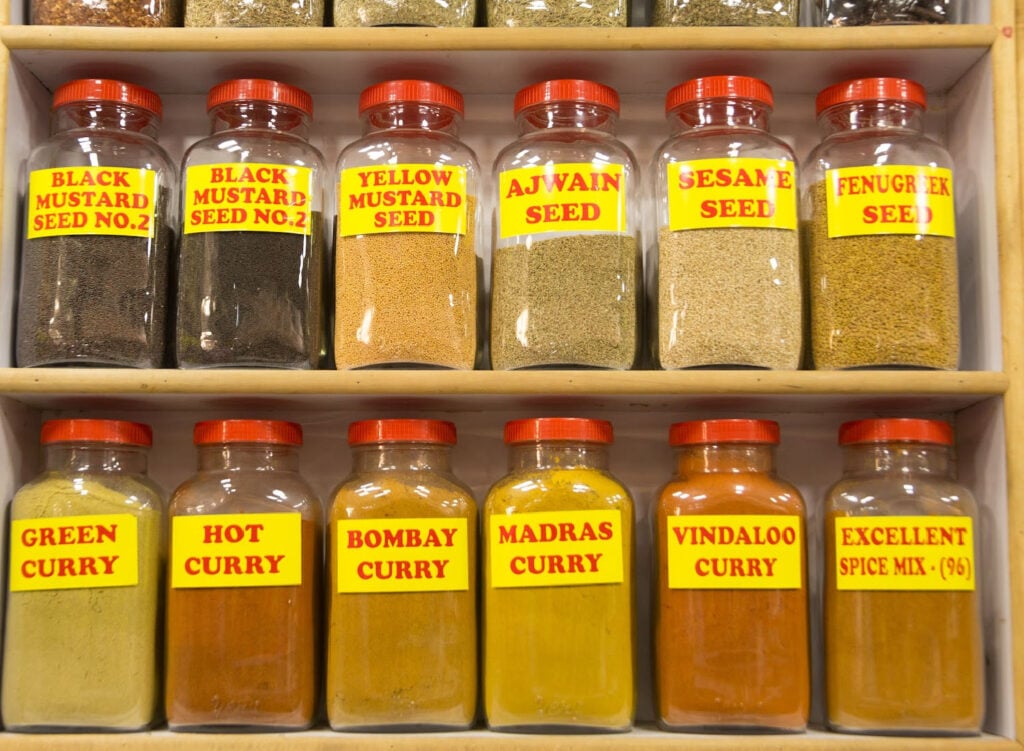Last Updated on September 18, 2021 by April

Many people who like to cook Indian dishes end up with curry powder that has lost its flavor. You may not always want to buy a new jar of curry powder after it loses its flavor, especially if you only need to use a teaspoon or two for your dish. Below are several substitutes you can use instead of curry powder.
What is Curry Powder?
Curry powder is a mixture of spices, usually including coriander, cumin, and turmeric. Different cultures and countries use varying recipes for curry powder, some with more than 30 spices.
Origin of Curry Powder
There are many theories about where the word curry came from. According to one idea, when British people in colonial India were trying to find a common name for all Indian dishes with spices, they found no equivalent in English or any other European language. The closest fit was something called Kari, which in Tamil means sauce. Another possible origin of the word is from a root that meant “sourness” in ancient Sanskrit. Since most Indian dishes with spices were sour, English speakers who noticed the similarity might have adopted this term.
What Curry Powder Tastes Like
Curry powder has a distinctive, complex flavor that is a little bitter and hot. If you aren’t familiar with it, you might be able to get an idea of its taste by combining cinnamon, nutmeg, red pepper flakes, fennel seeds, coriander seeds, cloves, garlic powder or onion powder, ginger powder or fresh ginger, and cumin.
Substitutes for Curry Powder

The good news for people who want to use curry powder substitutes in their cooking is that most recipes only need an ingredient or two from the list below. You can mix and match spices as long as you have some coriander, cumin, and turmeric on hand.
Here are some popular curry powder substitutes people like to experiment with when they don’t have any curry powder available.
Cumin, Coriander, Turmeric, and Ginger
Cumin, coriander, turmeric, and ginger can be mixed to taste to create a delicious curry powder substitution. Use a few teaspoons of each spice, which can be adjusted up or down depending on how much you need.
Spices to Make Madras Curry Powder
Madras curry powder is a little hotter than other types of curry powder. To make this type of mixture, you will want a teaspoon of each of cayenne pepper, ground ginger, ground cinnamon, ground cloves, ground black pepper, salt, cumin seeds, coriander seeds, or ground coriander, and turmeric powder.
Garam Masala
Garam masala is a spicy Indian mixture that adds flavor to meats and vegetables. It doesn’t contain turmeric, so it isn’t yellow like curry powder. Garam masala is often used in dishes like saag paneer.
Turmeric, Coriander, and All Spice
You can use turmeric, coriander, and All Spice to make a substitute for curry powder. Use a teaspoon of each.
Sambar Powder
Sambar powder is another possible curry powder substitute, and it is used in many southern Indian dishes. To make your own sambar powder, you should use cayenne pepper, ground coriander seed, black mustard seed, fenugreek seed, ground ginger, garlic powder, or clove powder asafoetida.
Cumin and All Spice
Cumin and All Spice is another simple recipe you can make at home. Use equal amounts of each spice, around two teaspoons.
Curry Paste
If you don’t have any curry powder, some brands of curry paste will work in a pinch. Madras and Jamaican curries can be found in most grocery stores, but other varieties might need to be purchased from an international store.
Chaat Masala
Chaat masala is a mixture that has the flavor of curry powder with citrus notes. If you happen to have some chaat masala in your kitchen, give this one a try. Make sure to add it in small increments, though, as chaat masala tends to have a little bit more of a kick than curry powder does.
Ground Cumin
Ground cumin is the right color but lacks the tang that makes curry powder so tasty. Still, you can use ground cumin if you run out of curry powder and don’t have time to run to the store. Add it in small amounts until your recipe tastes just right.
Want to learn about other food substitutions? Check out these marsala wine substitutes.
Curry Powder Tips

How to Make Your Curry Spicier
Do you love the subtle heat that comes from curry powder and would like to make your dish spicier? You can adjust the heat level by adding cayenne or chili pepper.
Curry Powder Uses
When you have access to fresh, fragrant spices like mustard seed, coriander, cinnamon, and fenugreek seeds, it makes sense to make your curry powder. It’s easy, but you need to give it a few days for the flavors to develop. You can keep this mixture on hand in your pantry or spice rack.
Curry Powder Storage
If you don’t plan on using up all of your homemade curry powder right away, store it in a tightly sealed jar in a cool, dry place. If you want to keep it fresh longer, store it in the refrigerator or freezer.
Indian Curry Vs. Other Countries
Indian Curry
Indian curries are a complex and vibrant blend of spices that leave your taste buds tingling. They can be made with dry ingredients like coriander, turmeric, cumin, fenugreek, and chili powder to provide intense flavors. They may also include other ingredients such as oil ghee yogurt for added moisture when mixed into dal.
Thai Curry
Thai food is some of the spiciest and most flavorful in the world. The fresh ingredients that go into making Thai curry make it quite spicy, but with a fantastic flavor to match!
Ingredients often used in Thai curry include hot chilies, lemongrass rootstalk extract, gingerroot knobs, bruised garlic cloves, raw shallots, shrimp paste, dried herbs, cumin seeds, coriander seeds, turmeric, and vinegar fish sauce.
In Thai food, curry is known as kari. This type of curry dish tastes a little different from Indian curries due to the addition of lemongrass and galangal, which gives it a sweeter taste.
Japanese Curry
Japanese curry sauces are made with spice powders, flour, and oil to give it a distinct brown color. These ingredients remain consistent in terms of both flavor and texture; however, the level at which these spices coat your tongue varies.
Japanese curries typically have more heft than other types because they contain beef or chicken while also including onions, carrots, and potatoes served over white rice for an additional layer that can soak up some sauce if necessary!
What Makes Curry Powder Yellow
Turmeric, the ingredient that provides color and flavor to curry powder, also gives it a yellow color. This spice comes from turmeric roots. It’s similar in appearance to ginger root but has a milder flavor, so it works well in baked goods, beverages, and other dishes.
Conclusion
So, these are some of the substitutes that you can use to replace curry powder. As for curry powder uses, it might be nice to know that you could use this spice in making papadam, curd rice, chicken korma, garam masala, and many other dishes!
I hope you enjoyed this post. If you have any substitutions for curry powder that you absolutely love, please share them with us. Thanks for reading!


